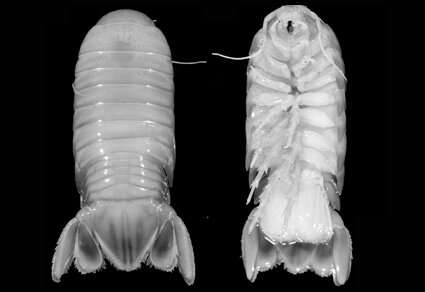This article has been reviewed according to Science X's editorial process and policies. Editors have highlighted the following attributes while ensuring the content's credibility:
fact-checked
peer-reviewed publication
trusted source
proofread
New deep-sea crustacean discovered in Bahamas

An international team of marine biologists including Oliver Shipley, Ph.D., of the School of Marine and Atmospheric Sciences (SoMAS) at Stony Brook University, have discovered a unique isopod, a form of crustacean, that has been formally identified as a new species of the genus Booralana from the deep waters of The Bahamas.
The finding, detailed in a paper published in the journal Zootaxa, is another example that discovery of life in the oceans is far from complete. By uncovering the creature's role in deep-sea ecosystems, scientists may be able to understand ocean biodiversity better.
Isopods are found ubiquitously across all major ecosystems on Earth. Many, like this new species, are only a few centimeters long. They evolved more than 300 million years ago. In the deep seas, they are mostly scavengers and are important recyclers of energy. Yet, there is evidence they can attack living vertebrates such as sharks. Isopods can also live several years without eating. This creature, Booraland nickorum, exhibits similar traits since its discovery at over 500 meters in Bahamian waters.
"This work highlights the cryptic diversity of this group and underscores how little we know about deep-sea ecosystems in The Bahamas," says Shipley, a Research Assistant Professor at SoMAS, who believes marine researchers are only scratching the surface of what these deep-sea ecosystems contain in terms of marine life, and that this latest finding suggests "a potentially hidden 'treasure chest' of unrecognized biodiversity in these waters."
In 2019, Shipley worked closely with OceanX and the Cape Eleuthera Institute on research that explored deep waters in the Exuma Sound. This region had initially been the focus of Shipley's MS research, beginning in 2013. The 2019-20 expedition was one of several taking place in the Sound aimed at documenting deep-sea biodiversity in its previously unexplored areas. During the expedition, the research team recovered specimens for genetic sequencing and, in the process, discovered the new isopod, Booralana nickorum.
For Shipley and colleagues, this is the second new species of isopod discovered as part of a long-term project in The Bahamas' Exuma Sound. The project has largely aimed to examine patterns of biodiversity and food web structure. The other isopod, Bathynomus maxeyorum, was formally described in 2016.
Prior to this discovery, it was believed that only a single species of Booralana existed in the Northwest Atlantic Ocean, Booralana tricarinata. The new species, B. nickorum, can be distinguished by several morphological features associated with the pleotelson, or 'tail."
Collaborating with Shipley in the discovery are several scientists from the University of Massachusetts Amherst, including Professor Duncan Irschick, who used novel technologies to create 3D models of the specimen.
"The Caribbean houses many deep-sea ecosystems that could be considered pristine, mostly hidden from anthropogenic exploitation, such as deep-sea fisheries and mining," explains Shipley.
"Therefore, they provide a baseline from which to compare exploitation effects occurring in less pristine regions. However, these systems are not immune from the increasing impacts of climate changes and pollution, so it is critical that we understand the full extent of the biodiversity supported by these deep-sea environments."
Shipley currently teaches an annual overseas field course at the Cape Eleuthera Institute, where undergraduate and graduate students work alongside Bahamian scientists to explore sub-tropical ecosystems, including the deep sea. This offers much exposure for Stony Brook students who directly participate in active discovery.
More information: Oliver N Shipley et al, A new species of deep-sea Booralana Bruce, 1986 (Crustacea: Isopoda: Cirolanidae) from The Bahamas, Western North Atlantic, Zootaxa (2024). DOI: 10.11646/zootaxa.5399.3.4
Journal information: Zootaxa
Provided by Stony Brook University





















